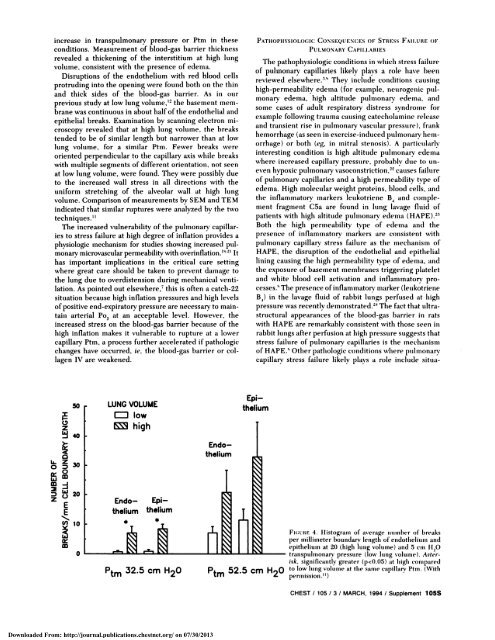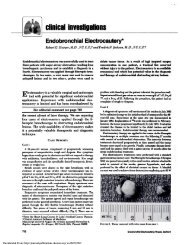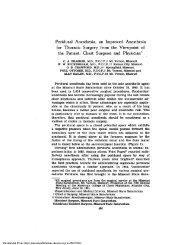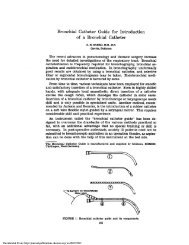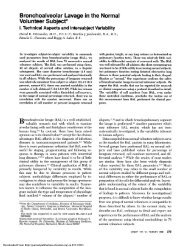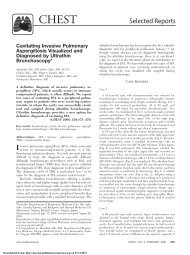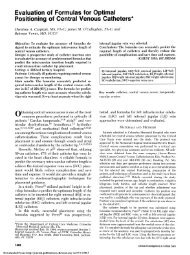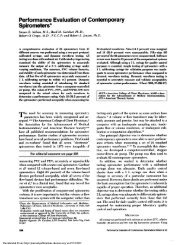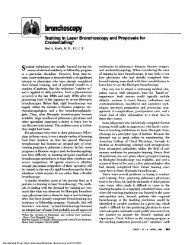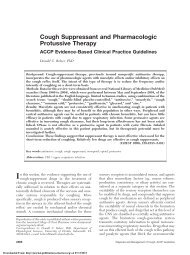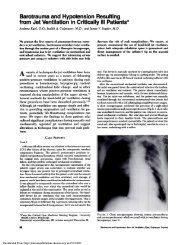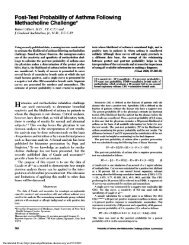Are Pulmonary Capillaries Susceptible to Mechanical ... - Journal
Are Pulmonary Capillaries Susceptible to Mechanical ... - Journal
Are Pulmonary Capillaries Susceptible to Mechanical ... - Journal
You also want an ePaper? Increase the reach of your titles
YUMPU automatically turns print PDFs into web optimized ePapers that Google loves.
20<br />
increase in traumspuhmomiary pressumre or Ptnu in tiuese<br />
comuditiomss. Measumremsient of blood-gas barrier tluickmuess<br />
reveaheci a thsickening of due interstitium at high iuuusg<br />
volimmsue, consistent with the presence of eciemsia.<br />
Disruptions of the eiuciothehitmmuu with red blood cells<br />
protruding in<strong>to</strong> tlse opening were foumudl both on the tisimu<br />
mine! thsick sides of time blood-gas harrier. As imu ouur<br />
previous sttmdv at low lumumg the batsemuuemmt mmuemiu-<br />
brane was continuouus in abouut half of the endothiehiat and<br />
epithselial breaks. Exasmmsinautiouu by scamsmuimug electron miii-<br />
crosc’op reveauled thiast at highs lummmg ‘ohumne’, the hireatks<br />
temucled <strong>to</strong> be of simsmilatr lemmgtls humt muasrro\s’er thmamu sit low<br />
hsmusg s’ohuunme, for a sinsilaur Ptnu. Fewer hreauks we’re’<br />
oriented! perpendictular <strong>to</strong> time capillary axis while breaks<br />
vithm mmuultipie segmsuents of differemut oriemutaitiomu, muot seems<br />
at low lung voluuusie, were foummud. They were possibl’ clue<br />
<strong>to</strong> tlse increatseci svssll stress in au directions with thue<br />
tmmsiformiu stretchsiuig of time alveolar waull ait high luusg<br />
voluumue. Commuparison cif msseasuuremsmesmts 1)51 SE M amid TE M<br />
indicated that simsuilar ruptlmres were anasIy’zed by the two<br />
techniques.’’<br />
Time mncreaused vumimierabihitv of the pumiumsomman’ caupiltaur-<br />
ies <strong>to</strong> stress failure at high degree of immflation provides at<br />
physiologic msuechsanismss for studies sisowiusg increased psulmssomsarx’<br />
mnicrovascuiar pernueabmiit withu o’erimsf1atiomm, ‘‘ It<br />
hams imusportant immiplicsutions in tlse criticsul care setting<br />
where greaut casre slsouuld lie tsikeuu <strong>to</strong> 1)rcveuit datussasge <strong>to</strong><br />
the lung clue <strong>to</strong> overdistemusioms citmrimug usseclsanicaul vemsti-<br />
lation. As poimuted out elsewhere,7 this is often at catchm-22<br />
situmsstion becaumse high imuflaution pressumres mimic! lsighs levels<br />
of positive emud-expira<strong>to</strong>rv pressumre are msecessarx’ <strong>to</strong> umiaius-<br />
tasium arterial Po, at sin ascceptambie level. However, the<br />
imscreaseci stress oms tise blood-gats harrier hiecasuse of tIme<br />
highs inflaution msmsukes it s’umhmmerable <strong>to</strong> ruuptture at a lower<br />
capihlasrs’ Ptmus, at process fumrther accelerated if pastimologic<br />
chamuges hatve occurred. ie, tIme l)lo(ud-gaus baurrier or edt-<br />
lagen IV are weakemsed.<br />
I<br />
z<br />
4o<br />
50<br />
E<br />
E<br />
F:<br />
LUNG VOLUME<br />
low<br />
high<br />
Endo- Epi-<br />
thehium thelium<br />
Endothelium<br />
iii 111<br />
Epi-<br />
thelium<br />
1L1<br />
tm 32.5 cm H20 tm 52.5 cm 1120<br />
Downloaded From: http://journal.publications.chestnet.org/ on 07/30/2013<br />
P\TIu(iI’IussI(iu.o;uc (Nsu:#{231}mdFx(:!-;s ou. Sru,ess Fsuiu iii’; u’<br />
Fu;uuu’: 4. I Iis<strong>to</strong>graumiu of auveu’auge mmuuumlhi,’r of’ hu’eaks<br />
per uiuitlimumeter houiumdatrv leumgthm oh (‘uudotlme’liuuuuu atmm(I<br />
epithmeti m ummstt 20 ( Im1gb hummug soh mummmc) some1 .5 c umm11,0<br />
trauuuspuulmmmuimmaurs- pressure (loss’ luuusg \-ol uuumme),Ate,’i.sk,<br />
sigumi I ic’asuutlv greater (p


